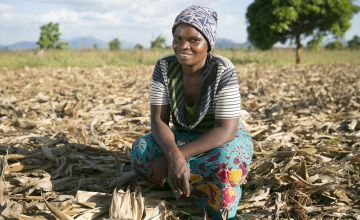
Knowledge Hub
As COP 28 gets underway, it's clear that climate change is putting an enormous strain on the world’s most vulnerable people. Extreme temperatures, unpredictable weather patterns, shorter growing seasons, droughts, floods, and increased exposure to pests and crop diseases are making it more difficult for communities that rely on farming to survive and earn a living.
But there are techniques that can help people adapt to and prepare for some of these changes so that they can continue to put food on the table and keep their livelihoods going – and even improve them. That’s where Climate-Smart Agriculture comes in.
Why is it ‘smart’?
Climate-Smart Agriculture (CSA) is a way of combining different sustainable methods of farming to tackle the specific climate challenges of a community. It is not a ‘one size fits all’ approach, so finding the right combination to manage these obstacles is what makes Climate-Smart Agriculture ‘smart’.
Concern’s approach to Climate-Smart Agriculture is to help vulnerable people improve their farming productivity, enabling them to build resilient, sustainable livelihoods – despite the climate challenges they are facing now or are likely to face in the future. But it is not at any cost. The key is to do it in ways that protect the local environment and using methods that do not contribute to the climate crisis.
Here are just three of those CSA techniques tried and tested by Concern that are making a difference to communities around the world.
Three techniques that are making a difference
1. Conservation Agriculture
The methods are quick and easy for farmers to put into practice – and involve planting seeds in small holes or basins instead of ploughed furrows, using stalks and leaves from the previous harvest to cover the ground, and alternating the type of plant grown each year. For the soil, these techniques help to reduce erosion and loss of moisture and improve the fertility of the land. The benefits to the farmer are that they can cope better when faced with unreliable rainfall patterns and shorter growing seasons.

Agnes Jack has been practicing conservation agriculture techniques on her plot of land near Lowalika in Malawi - a country that is susceptible to extreme weather from severe flooding to prolonged dry spells and droughts. After planting corn seeds, she covered the ground with the dried stalks and leaves of her previous season’s harvest to help retain moisture and nutrients.
Conservation agriculture is the centrepiece of Climate-Smart Agriculture. It is a highly efficient farming system that makes use of three simple techniques: the least possible disturbance of the soil, permanently covering the surface with organic matter, and rotating crops.
2. System for Rice Intensification
Rather than growing rice in permanently flooded fields, this system for rice intensification involves managing irrigation to make sure that the rice crop receives enough water to grow without the soil becoming waterlogged. That makes it ideal in areas where water supplies are limited. And because seedlings are planted at wider intervals to encourage the growth of additional shoots and deeper root growth, fewer seeds are required than for conventional rice production - an important consideration for farmers who rely on rice as their staple food.


Alfred Tarawalie lives in a remote part of Tonkolili, Sierra Leone – where torrential rain combined with more frequent and prolonged dry spells are having an impact on harvests.
After two years on Concern’s rice intensification project, his rice crop yields have increased.
We plant one kilo of rice and harvest a much greater yield than what we traditionally would have.
The difference is that we get more this way than the old way - we plant less but get more. I can cultivate rice three times each year, and that’s why we are able to survive as a family. My neighbours are just planting while I am harvesting.
3. Adapted crop varieties
Growing crops in areas at risk of flooding from salt water or from prolonged periods of drought has often meant that farmers have to go without when disaster strikes. But new varieties of seeds are now available that can tolerate saline soils and can be grown on fields that have been contaminated by seawater.
Similarly, there are now seed varieties that are adapted to grow in drought conditions. In emergency situations, Concern distributes quick maturing varieties of seeds to shorten the growing season. This is particularly useful after crops have been washed away or destroyed – or when there is a threat of flooding or extreme dry spells. There are also varieties that tolerate drought and high temperatures – by becoming dormant, surviving dehydration, and adapting leaf structure to reduce loss of moisture.


Mika Abdu has grown short-season millet from seeds supplied by Concern in the Tahoua region of Niger - an area that is adversely affected by failed rains, dry spells and rises in temperatures. By using short-season seeds, Mika has been able to harvest his millet crop in half the time.
The advantage for my family is that we don’t have to wait as long for food. It used to take more than three months for the local millet to grow. But with this new variety, we can harvest in two months.
We’ve also been taught new farming techniques, such as the benefits of using compost, and how to keep moisture in the soil. And we’ve learned not to cut down all the young tree saplings. Before, we’d clear the land of everything. Now we protect the growing trees.
Concern works alongside communities like Agnes', Alfred's and Mika's to limit the worst effects of climate change.
Together, we use expert techniques to improve farming and access to food.

Other ways to help
Donate now
Give a one-off, or a monthly, donation today.
Join an event
From mountain trekking to marathon running, join us for one of our many exciting outdoor events!
Buy a gift
With an extensive range of alternative gifts, we have something to suit everybody.
Leave a gift in your will
Leave the world a better place with a life-changing legacy.
Become a corporate supporter
We partner with a range of organisations that share our passion and the results have been fantastic.
Create your own fundraising event
Raise money for Concern by organising your own charity fundraising event.





